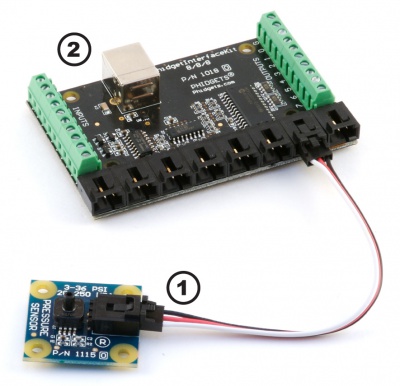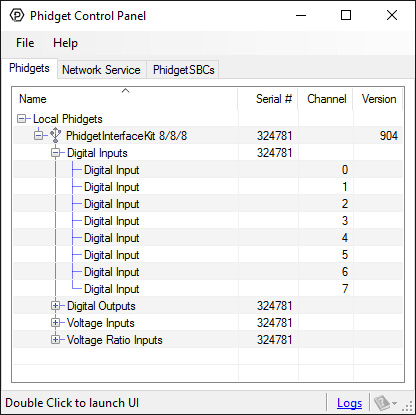1115 User Guide: Difference between revisions
No edit summary |
|||
| (19 intermediate revisions by 3 users not shown) | |||
| Line 1: | Line 1: | ||
__NOINDEX__ | |||
<metadesc>The Phidgets Gas Pressure Sensor plugs into an Analog Input or VINT Hub port and measures pressure from 20 kPa to 250 kPa.</metadesc> | |||
[[Category:UserGuide]] | [[Category:UserGuide]] | ||
==Getting Started== | ==Getting Started== | ||
{{UgSensorIntro|1115|Pressure Sensor|Voltage Ratio Input port}} | |||
Next, you will need to connect the pieces: | |||
[[Image:1115_0_Connecting_The_Hardware.jpg|400px|right|link=]] | |||
# Connect the 1115 to the 1018 with the Phidget cable. | |||
# Connect the 1018 to your computer with the USB cable. | |||
# | |||
# | |||
= | <br clear="all"> | ||
{{UGIntroDone|1115}} | |||
{{ | ==Using the 1115== | ||
{{UGcontrolpanelSensor|1115|1018}} | |||
{{UGSensorVoltageRatioInput|1115|pressure (kPa)}} | |||
{{ | |||
==Technical Details== | ==Technical Details== | ||
Measures absolute gas pressure from | ===General=== | ||
Measures absolute gas pressure from 20kPa to 250kPa. The sensor can safely withstand pressures beyond 250kPa, but it will saturate and report 250kPa for any value above. The sensor will not be physically damaged by pressure until approximately 1000kPa. | |||
'''Note:''' If you are interested in the difference in pressure between two points (Atmospheric vs. Human lungs for example) this sensor would not be appropriate. The gas pressure sensor required for this type of application is referred to as differential. | '''Note:''' If you are interested in the difference in pressure between two points (Atmospheric vs. Human lungs for example) this sensor would not be appropriate. The gas pressure sensor required for this type of application is referred to as differential. | ||
===Formulas=== | ===Formulas=== | ||
The Formula to translate | {{UGSensorFormula|pressure (kPa)}} The Formula to translate voltage into pressure is: | ||
<math>\text{Pressure (in | ::<math> | ||
\text{Pressure (in kPa)} = (\text{Voltage} \times 50) + 10 | |||
</math> | |||
===Barometric Temperature Correction=== | |||
The 1115 reports the absolute pressure of its surroundings. In other words, the pressure compared to a perfect vacuum. If you plan on using the 1115 as a barometer, you need to convert to barometric pressure. You can use conversion calculators such as this [http://www.csgnetwork.com/barcorrecthcalc.html above sea level barometer reading correction calculator] to make the adjustment based on your location's elevation. | |||
{{UGasens}} | {{UGasens}} | ||
{{UGnext|}} | |||
{{ | |||
Latest revision as of 20:57, 8 May 2018
Getting Started
Welcome to the 1115 user guide! In order to get started, make sure you have the following hardware on hand:
- 1115 - Pressure Sensor
- Any Phidget with a Voltage Ratio Input port, here are some compatible products. We will be using the VINT Hub for this guide.
- USB cable and computer
- Phidget cable
Next, you will need to connect the pieces:

- Connect the 1115 to the 1018 with the Phidget cable.
- Connect the 1018 to your computer with the USB cable.
Now that you have everything together, let's start using the 1115!
Using the 1115
Phidget Control Panel
In order to demonstrate the functionality of the 1115, we will connect it to the 1018, and then run an example using the Phidget Control Panel on a Windows machine.
The Phidget Control Panel is available for use on both macOS and Windows machines. If you would like to follow along, first take a look at the getting started guide for your operating system:
Linux users can follow the getting started with Linux guide and continue reading here for more information about the 1115.
First Look
After plugging in the 1115 into the 1018, and the 1018 into your computer, open the Phidget Control Panel. You will see something like this:

The Phidget Control Panel will list all connected Phidgets and associated objects, as well as the following information:
- Serial number: allows you to differentiate between similar Phidgets.
- Channel: allows you to differentiate between similar objects on a Phidget.
- Version number: corresponds to the firmware version your Phidget is running. If your Phidget is listed in red, your firmware is out of date. Update the firmware by double-clicking the entry.
The Phidget Control Panel can also be used to test your device. Double-clicking on an object will open an example.
Voltage Ratio Input
Double-click on a Voltage Ratio Input object in order to run the example:

General information about the selected object will be displayed at the top of the window. You can also experiment with the following functionality:
- Modify the change trigger and/or data interval value by dragging the sliders. For more information on these settings, see the data interval/change trigger page.
- Select the 1115 from the Sensor Type drop-down menu. The example will now convert the voltage into pressure (kPa) automatically. Converting the voltage to pressure (kPa) is not specific to this example, it is handled by the Phidget libraries, with functions you have access to when you begin developing!
Technical Details
General
Measures absolute gas pressure from 20kPa to 250kPa. The sensor can safely withstand pressures beyond 250kPa, but it will saturate and report 250kPa for any value above. The sensor will not be physically damaged by pressure until approximately 1000kPa.
Note: If you are interested in the difference in pressure between two points (Atmospheric vs. Human lungs for example) this sensor would not be appropriate. The gas pressure sensor required for this type of application is referred to as differential.
Formulas
The Phidget libraries can automatically convert sensor voltage into pressure (kPa) by selecting the appropriate SensorType. See the Phidget22 API for more details. The Formula to translate voltage into pressure is:
Barometric Temperature Correction
The 1115 reports the absolute pressure of its surroundings. In other words, the pressure compared to a perfect vacuum. If you plan on using the 1115 as a barometer, you need to convert to barometric pressure. You can use conversion calculators such as this above sea level barometer reading correction calculator to make the adjustment based on your location's elevation.
Phidget Cable

The Phidget Cable is a 3-pin, 0.100 inch pitch locking connector. Pictured here is a plug with the connections labelled. The connectors are commonly available - refer to the Analog Input Primer for manufacturer part numbers.
What to do Next
- Programming Languages - Find your preferred programming language here and learn how to write your own code with Phidgets!
- Phidget Programming Basics - Once you have set up Phidgets to work with your programming environment, we recommend you read our page on to learn the fundamentals of programming with Phidgets.

